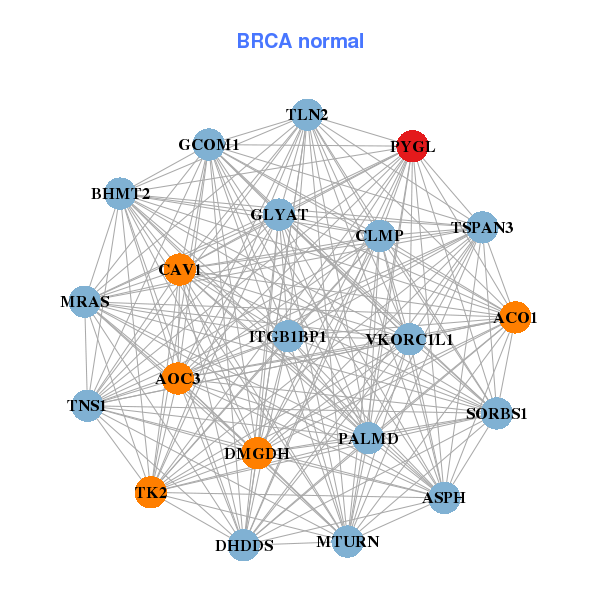|
|||||||||||||||||||||||||||||||||||||||||||||||||||||||||||||||||||||||||||||||||||||||||||||||||||||||||||||||||||||||||||||||||||||||||||||||||||||||||||||||||||||||||||||||||||||||||||||||||||||||||||||||||||||||||||||||||||||||||||||||||||||||||||||||||||||||||||||||||||||||||||||||||||||||||||||||||||||||||||||||||||||||||||||||||||||||||||||||||||||||||||||||||||||||||||||||||||||||||||||||||||||
| |
| Phenotypic Information (metabolism pathway, cancer, disease, phenome) |
| |
| |
| Gene-Gene Network Information: Co-Expression Network, Interacting Genes & KEGG |
| |
|
| Gene Summary for PYGL |
| Basic gene info. | Gene symbol | PYGL |
| Gene name | phosphorylase, glycogen, liver | |
| Synonyms | GSD6 | |
| Cytomap | UCSC genome browser: 14q21-q22 | |
| Genomic location | chr14 :51371934-51411248 | |
| Type of gene | protein-coding | |
| RefGenes | NM_001163940.1, NM_002863.4, | |
| Ensembl id | ENSG00000100504 | |
| Description | glycogen phosphorylase, liver form | |
| Modification date | 20141219 | |
| dbXrefs | MIM : 613741 | |
| HGNC : HGNC | ||
| Ensembl : ENSG00000100504 | ||
| HPRD : 01987 | ||
| Vega : OTTHUMG00000166596 | ||
| Protein | UniProt: go to UniProt's Cross Reference DB Table | |
| Expression | CleanEX: HS_PYGL | |
| BioGPS: 5836 | ||
| Gene Expression Atlas: ENSG00000100504 | ||
| The Human Protein Atlas: ENSG00000100504 | ||
| Pathway | NCI Pathway Interaction Database: PYGL | |
| KEGG: PYGL | ||
| REACTOME: PYGL | ||
| ConsensusPathDB | ||
| Pathway Commons: PYGL | ||
| Metabolism | MetaCyc: PYGL | |
| HUMANCyc: PYGL | ||
| Regulation | Ensembl's Regulation: ENSG00000100504 | |
| miRBase: chr14 :51,371,934-51,411,248 | ||
| TargetScan: NM_001163940 | ||
| cisRED: ENSG00000100504 | ||
| Context | iHOP: PYGL | |
| cancer metabolism search in PubMed: PYGL | ||
| UCL Cancer Institute: PYGL | ||
| Assigned class in ccmGDB | C | |
| Top |
| Phenotypic Information for PYGL(metabolism pathway, cancer, disease, phenome) |
| Cancer | CGAP: PYGL |
| Familial Cancer Database: PYGL | |
| * This gene is included in those cancer gene databases. |
|
|
|
|
|
|
| |||||||||||||||||||||||||||||||||||||||||||||||||||||||||||||||||||||||||||||||||||||||||||||||||||||||||||||||||||||||||||||||||||||||||||||||||||||||||||||||||||||||||||||||||||||||||||||||||||||||||||||||||||||||||||||||||||||||||||||||||||||||||||||||||||||||||||||||||||||||||||||||||||||||||||||||||||||||||||||||||||||||||||||||||||||||||||||||||||||||||||||||||||||||||||||||||||||||||||||||
Oncogene 1 | Significant driver gene in | ||||||||||||||||||||||||||||||||||||||||||||||||||||||||||||||||||||||||||||||||||||||||||||||||||||||||||||||||||||||||||||||||||||||||||||||||||||||||||||||||||||||||||||||||||||||||||||||||||||||||||||||||||||||||||||||||||||||||||||||||||||||||||||||||||||||||||||||||||||||||||||||||||||||||||||||||||||||||||||||||||||||||||||||||||||||||||||||||||||||||||||||||||||||||||||||||||||||||||||||||||||
| cf) number; DB name 1 Oncogene; http://nar.oxfordjournals.org/content/35/suppl_1/D721.long, 2 Tumor Suppressor gene; https://bioinfo.uth.edu/TSGene/, 3 Cancer Gene Census; http://www.nature.com/nrc/journal/v4/n3/abs/nrc1299.html, 4 CancerGenes; http://nar.oxfordjournals.org/content/35/suppl_1/D721.long, 5 Network of Cancer Gene; http://ncg.kcl.ac.uk/index.php, 1Therapeutic Vulnerabilities in Cancer; http://cbio.mskcc.org/cancergenomics/statius/ |
| KEGG_STARCH_AND_SUCROSE_METABOLISM REACTOME_METABOLISM_OF_CARBOHYDRATES REACTOME_GLUCOSE_METABOLISM | |
| OMIM | |
| Orphanet | |
| Disease | KEGG Disease: PYGL |
| MedGen: PYGL (Human Medical Genetics with Condition) | |
| ClinVar: PYGL | |
| Phenotype | MGI: PYGL (International Mouse Phenotyping Consortium) |
| PhenomicDB: PYGL | |
| Mutations for PYGL |
| * Under tables are showing count per each tissue to give us broad intuition about tissue specific mutation patterns.You can go to the detailed page for each mutation database's web site. |
| There's no structural variation information in COSMIC data for this gene. |
| * From mRNA Sanger sequences, Chitars2.0 arranged chimeric transcripts. This table shows PYGL related fusion information. |
| ID | Head Gene | Tail Gene | Accession | Gene_a | qStart_a | qEnd_a | Chromosome_a | tStart_a | tEnd_a | Gene_a | qStart_a | qEnd_a | Chromosome_a | tStart_a | tEnd_a |
| AA147640 | PYGL | 1 | 258 | 14 | 51371938 | 51372197 | STON1-GTF2A1L | 253 | 417 | 2 | 48824707 | 48824871 | |
| Top |
| Mutation type/ Tissue ID | brca | cns | cerv | endome | haematopo | kidn | Lintest | liver | lung | ns | ovary | pancre | prost | skin | stoma | thyro | urina | |||
| Total # sample | 2 | |||||||||||||||||||
| GAIN (# sample) | 2 | |||||||||||||||||||
| LOSS (# sample) |
| cf) Tissue ID; Tissue type (1; Breast, 2; Central_nervous_system, 3; Cervix, 4; Endometrium, 5; Haematopoietic_and_lymphoid_tissue, 6; Kidney, 7; Large_intestine, 8; Liver, 9; Lung, 10; NS, 11; Ovary, 12; Pancreas, 13; Prostate, 14; Skin, 15; Stomach, 16; Thyroid, 17; Urinary_tract) |
| Top |
|
 |
| Top |
| Stat. for Non-Synonymous SNVs (# total SNVs=60) | (# total SNVs=24) |
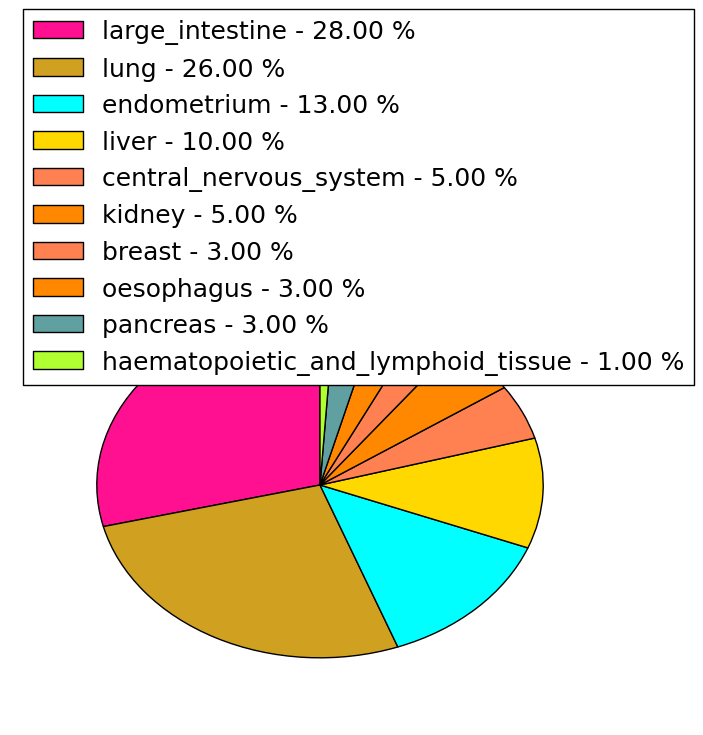 |  |
(# total SNVs=1) | (# total SNVs=0) |
 |
| Top |
| * When you move the cursor on each content, you can see more deailed mutation information on the Tooltip. Those are primary_site,primary_histology,mutation(aa),pubmedID. |
| GRCh37 position | Mutation(aa) | Unique sampleID count |
| chr14:51387292-51387292 | p.E274E | 2 |
| chr14:51375596-51375596 | p.S752Y | 2 |
| chr14:51378988-51378988 | p.T552S | 2 |
| chr14:51376786-51376786 | p.S668S | 2 |
| chr14:51375596-51375597 | p.S752fs*6 | 2 |
| chr14:51382068-51382068 | p.I463I | 2 |
| chr14:51382098-51382098 | p.V453V | 2 |
| chr14:51378726-51378726 | p.F599F | 2 |
| chr14:51378457-51378457 | p.A654T | 2 |
| chr14:51387719-51387719 | p.R243C | 2 |
| Top |
|
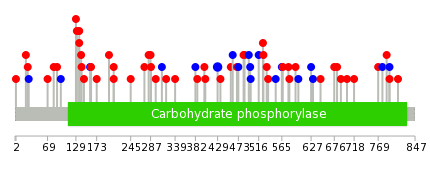 |
| Point Mutation/ Tissue ID | 1 | 2 | 3 | 4 | 5 | 6 | 7 | 8 | 9 | 10 | 11 | 12 | 13 | 14 | 15 | 16 | 17 | 18 | 19 | 20 |
| # sample | 2 | 2 | 1 | 10 | 1 | 5 | 2 | 1 | 6 | 3 | 10 | 9 | 9 | |||||||
| # mutation | 2 | 2 | 1 | 12 | 1 | 5 | 2 | 1 | 6 | 3 | 16 | 9 | 10 | |||||||
| nonsynonymous SNV | 1 | 2 | 7 | 1 | 3 | 2 | 1 | 6 | 2 | 9 | 8 | 8 | ||||||||
| synonymous SNV | 1 | 1 | 5 | 2 | 1 | 7 | 1 | 2 |
| cf) Tissue ID; Tissue type (1; BLCA[Bladder Urothelial Carcinoma], 2; BRCA[Breast invasive carcinoma], 3; CESC[Cervical squamous cell carcinoma and endocervical adenocarcinoma], 4; COAD[Colon adenocarcinoma], 5; GBM[Glioblastoma multiforme], 6; Glioma Low Grade, 7; HNSC[Head and Neck squamous cell carcinoma], 8; KICH[Kidney Chromophobe], 9; KIRC[Kidney renal clear cell carcinoma], 10; KIRP[Kidney renal papillary cell carcinoma], 11; LAML[Acute Myeloid Leukemia], 12; LUAD[Lung adenocarcinoma], 13; LUSC[Lung squamous cell carcinoma], 14; OV[Ovarian serous cystadenocarcinoma ], 15; PAAD[Pancreatic adenocarcinoma], 16; PRAD[Prostate adenocarcinoma], 17; SKCM[Skin Cutaneous Melanoma], 18:STAD[Stomach adenocarcinoma], 19:THCA[Thyroid carcinoma], 20:UCEC[Uterine Corpus Endometrial Carcinoma]) |
| Top |
| * We represented just top 10 SNVs. When you move the cursor on each content, you can see more deailed mutation information on the Tooltip. Those are primary_site, primary_histology, mutation(aa), pubmedID. |
| Genomic Position | Mutation(aa) | Unique sampleID count |
| chr14:51382068 | p.I429I,PYGL | 2 |
| chr14:51376660 | p.E631E,PYGL | 1 |
| chr14:51383390 | p.D495D,PYGL | 1 |
| chr14:51378932 | p.D298E,PYGL | 1 |
| chr14:51390727 | p.K136T,PYGL | 1 |
| chr14:51381427 | p.T627T,PYGL | 1 |
| chr14:51404508 | p.T486M,PYGL | 1 |
| chr14:51372121 | p.G288V,PYGL | 1 |
| chr14:51376748 | p.G131E,PYGL | 1 |
| chr14:51383417 | p.D600D,PYGL | 1 |
| * Copy number data were extracted from TCGA using R package TCGA-Assembler. The URLs of all public data files on TCGA DCC data server were gathered on Jan-05-2015. Function ProcessCNAData in TCGA-Assembler package was used to obtain gene-level copy number value which is calculated as the average copy number of the genomic region of a gene. |
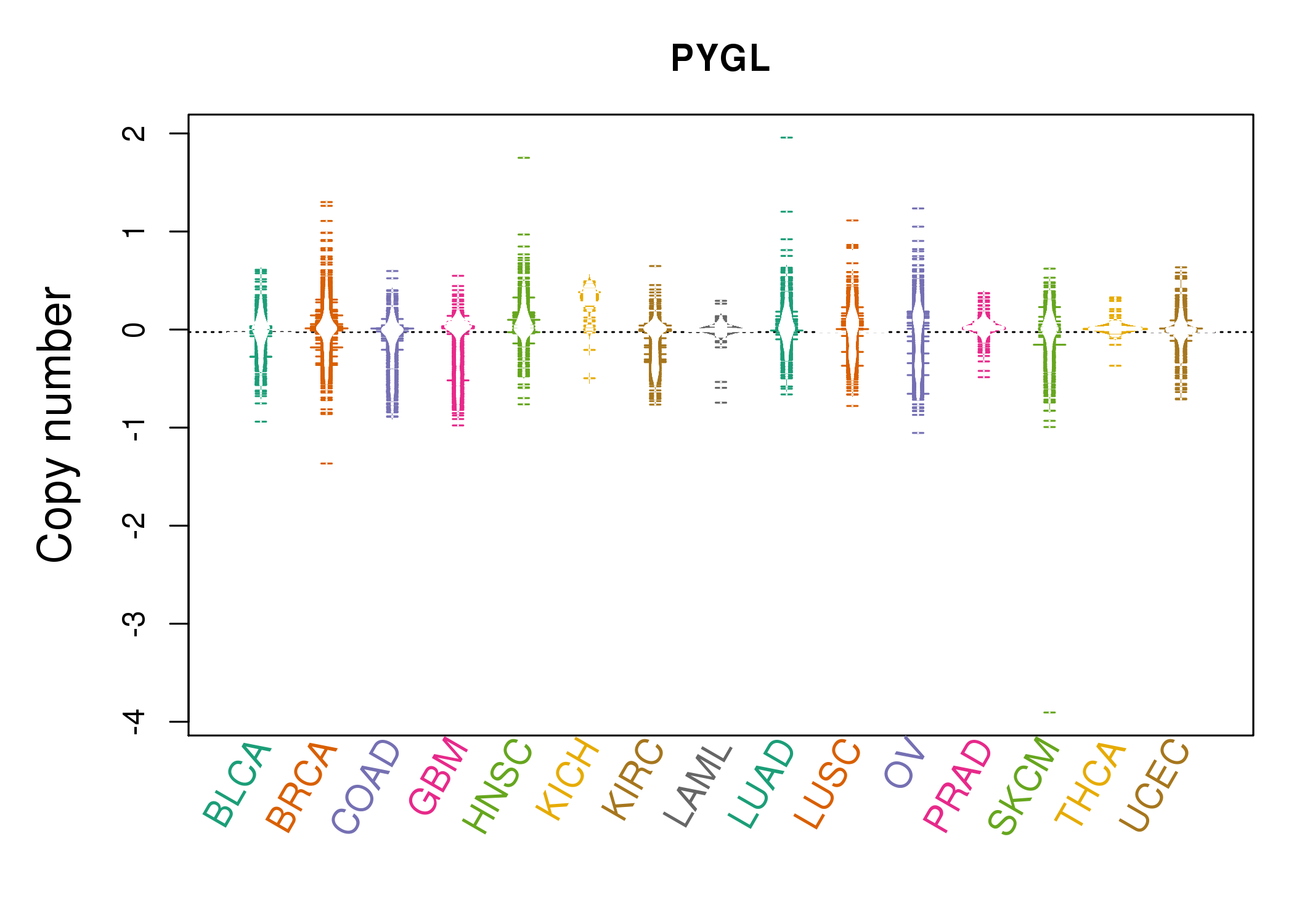 |
| cf) Tissue ID[Tissue type]: BLCA[Bladder Urothelial Carcinoma], BRCA[Breast invasive carcinoma], CESC[Cervical squamous cell carcinoma and endocervical adenocarcinoma], COAD[Colon adenocarcinoma], GBM[Glioblastoma multiforme], Glioma Low Grade, HNSC[Head and Neck squamous cell carcinoma], KICH[Kidney Chromophobe], KIRC[Kidney renal clear cell carcinoma], KIRP[Kidney renal papillary cell carcinoma], LAML[Acute Myeloid Leukemia], LUAD[Lung adenocarcinoma], LUSC[Lung squamous cell carcinoma], OV[Ovarian serous cystadenocarcinoma ], PAAD[Pancreatic adenocarcinoma], PRAD[Prostate adenocarcinoma], SKCM[Skin Cutaneous Melanoma], STAD[Stomach adenocarcinoma], THCA[Thyroid carcinoma], UCEC[Uterine Corpus Endometrial Carcinoma] |
| Top |
| Gene Expression for PYGL |
| * CCLE gene expression data were extracted from CCLE_Expression_Entrez_2012-10-18.res: Gene-centric RMA-normalized mRNA expression data. |
 |
| * Normalized gene expression data of RNASeqV2 was extracted from TCGA using R package TCGA-Assembler. The URLs of all public data files on TCGA DCC data server were gathered at Jan-05-2015. Only eight cancer types have enough normal control samples for differential expression analysis. (t test, adjusted p<0.05 (using Benjamini-Hochberg FDR)) |
 |
| Top |
| * This plots show the correlation between CNV and gene expression. |
: Open all plots for all cancer types
 |
|
 |
|
| Top |
| Gene-Gene Network Information |
| * Co-Expression network figures were drawn using R package igraph. Only the top 20 genes with the highest correlations were shown. Red circle: input gene, orange circle: cell metabolism gene, sky circle: other gene |
: Open all plots for all cancer types
 |
| ||||
| ATP6V1D,CGRRF1,ELL2,FAM120AOS,FAM162A,GPC5,HHEX, HSDL2,KCNS3,KLHDC2,KTN1,PDE4A,PIGH,PTPLAD2, PYGL,STON2,TMX1,TPST2,TRIM9,ZAK,ZNF385D | ACO1,AOC3,CLMP,ASPH,BHMT2,MTURN,CAV1, DHDDS,DMGDH,GCOM1,GLYAT,ITGB1BP1,MRAS,PALMD, PYGL,SORBS1,TK2,TLN2,TNS1,TSPAN3,VKORC1L1 | ||||
 |
| ||||
| AIF1L,AKT1,ANO1,CCDC109B,FAM115C,FNTB,GOLGA5, HPSE,KCNK1,LOC152225,LY6E,MAP6D1,MARK3,NIN, PARP2,PYGL,RGS10,SAV1,TMX1,TRIB2,WDHD1 | ABHD12B,ASTL,CCNJ,CKAP4,DMRT2,EXOC3L2,FGFRL1, GPAT2,IL1RL2,LRFN4,MTNR1A,NOX1,NSUN7,PITX1, PPM1H,PREP,PYGL,RHOV,TMEM44,XRRA1,ZDHHC16 |
| * Co-Expression network figures were drawn using R package igraph. Only the top 20 genes with the highest correlations were shown. Red circle: input gene, orange circle: cell metabolism gene, sky circle: other gene |
: Open all plots for all cancer types
| Top |
: Open all interacting genes' information including KEGG pathway for all interacting genes from DAVID
| Top |
| Pharmacological Information for PYGL |
| DB Category | DB Name | DB's ID and Url link |
| * Gene Centered Interaction Network. |
 |
| * Drug Centered Interaction Network. |
| DrugBank ID | Target Name | Drug Groups | Generic Name | Drug Centered Network | Drug Structure |
| DB00114 | phosphorylase, glycogen, liver | nutraceutical | Pyridoxal Phosphate | 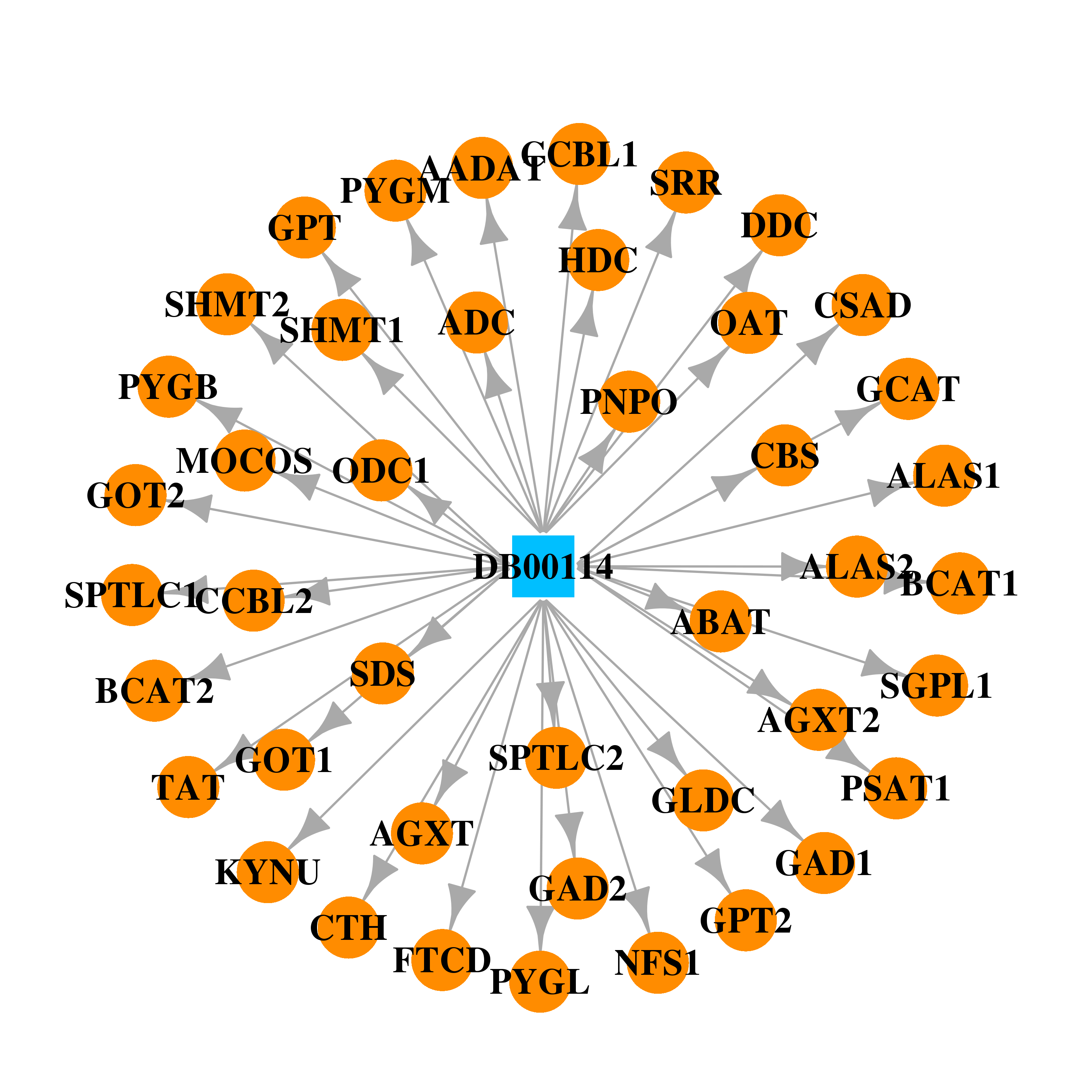 | 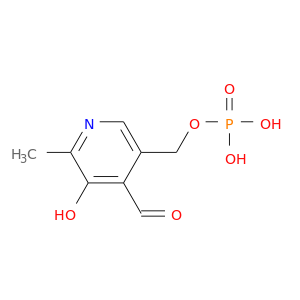 |
| DB00131 | phosphorylase, glycogen, liver | approved; nutraceutical | Adenosine monophosphate |  | 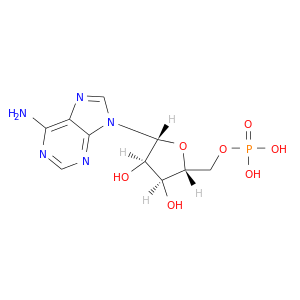 |
| DB01696 | phosphorylase, glycogen, liver | experimental | 7,9-Dihydro-1h-Purine-2,6,8(3h)-Trione | 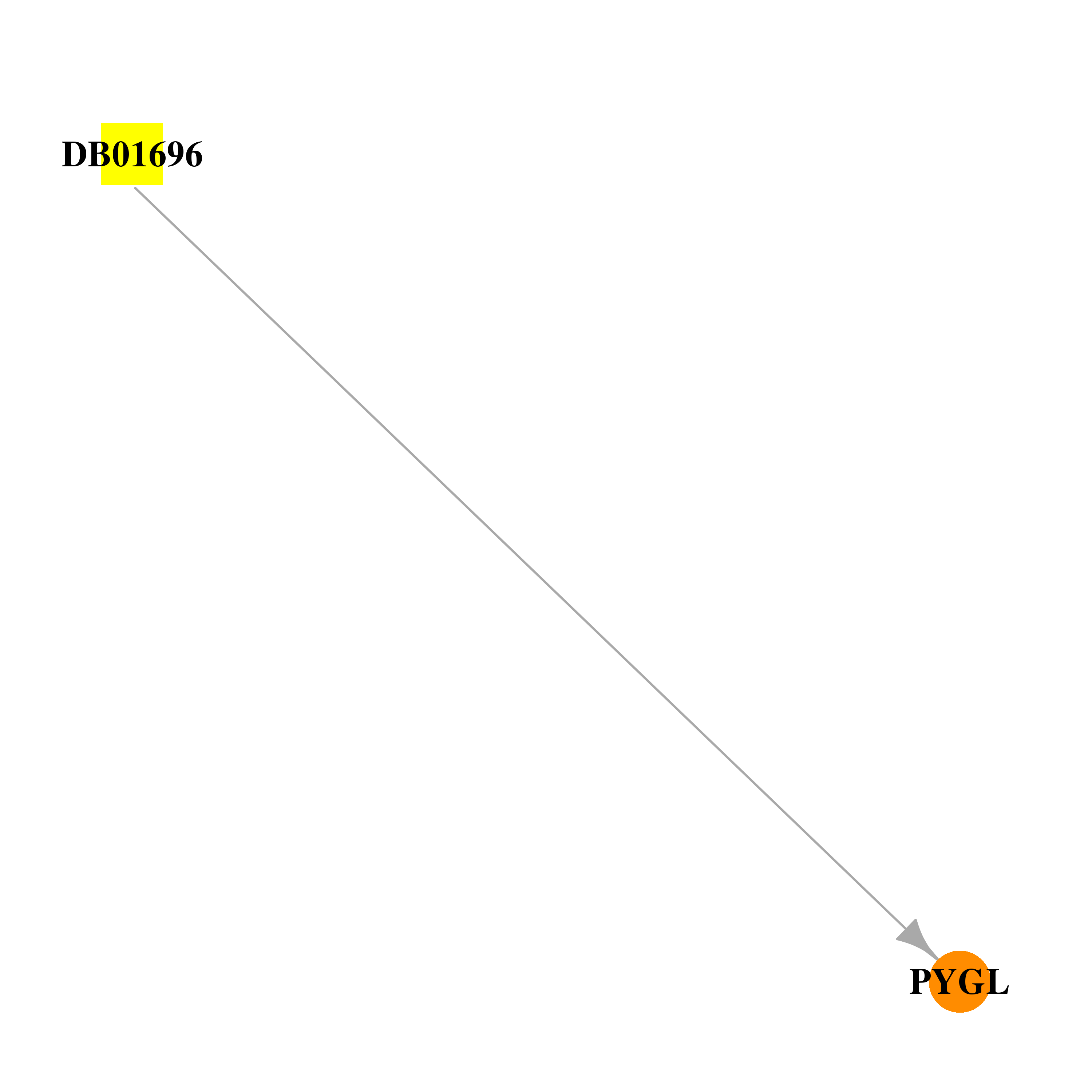 | 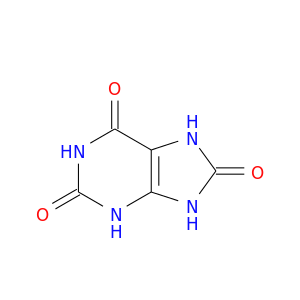 |
| DB02089 | phosphorylase, glycogen, liver | experimental | CP-526423 |  |  |
| DB02320 | phosphorylase, glycogen, liver | experimental | 1-N-Acetyl-Beta-D-Glucosamine | 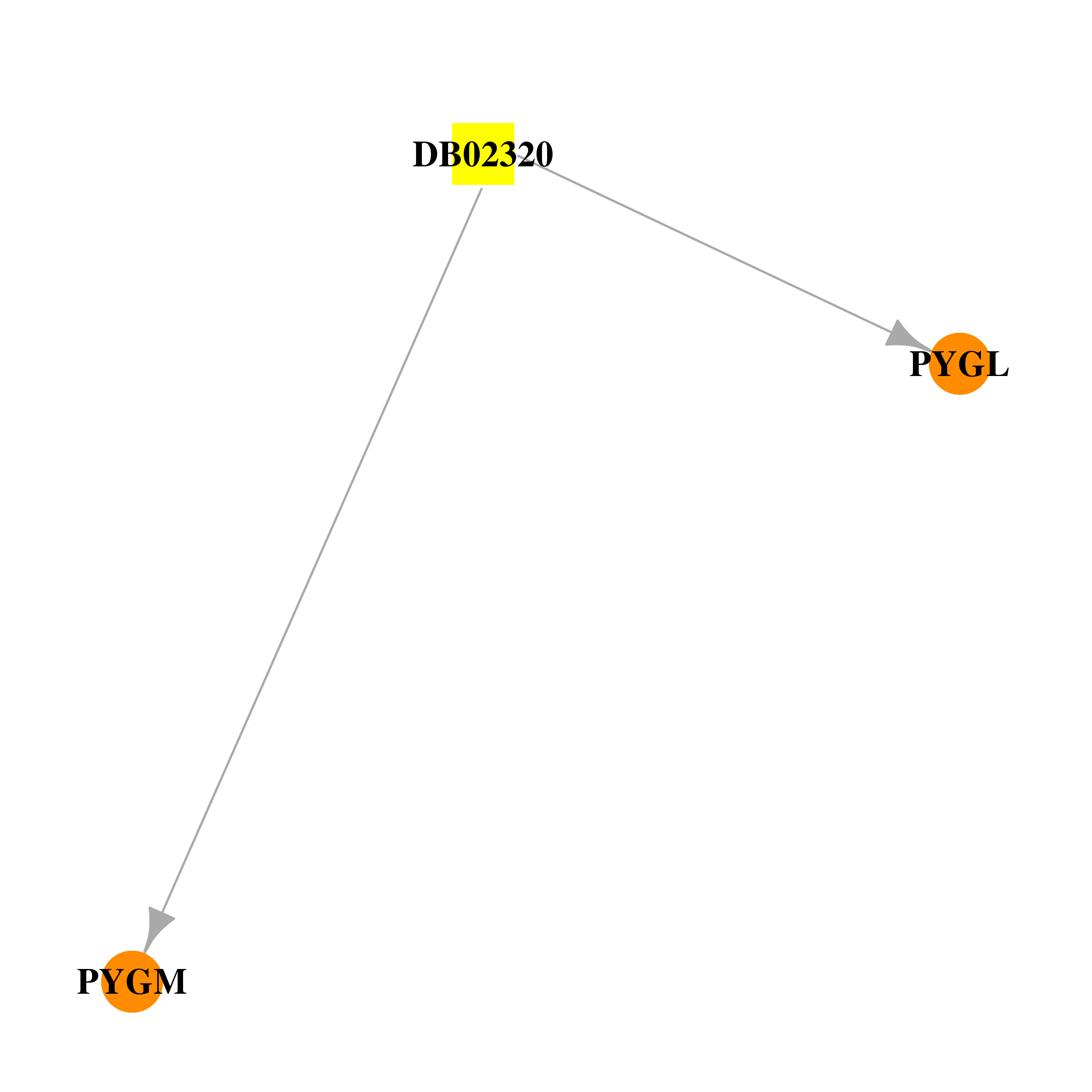 |  |
| DB02379 | phosphorylase, glycogen, liver | experimental | Beta-D-Glucose |  | 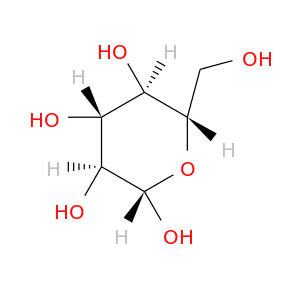 |
| DB03288 | phosphorylase, glycogen, liver | experimental | 5-Chloro-1h-Indole-2-Carboxylic Acid{[Cyclopentyl-(2-Hydroxy-Ethyl)-Carbamoyl]-Methyl}-Amide |  |  |
| DB03744 | phosphorylase, glycogen, liver | experimental | Cp403700, (S)-1-{2-[(5-Chloro-1h-Indole-2-Carbonyl)-Amino]-3-Phenyl-Propionyl}-Azetidine-3-Carboxylate |  |  |
| DB04522 | phosphorylase, glycogen, liver | experimental | Phosphonoserine | 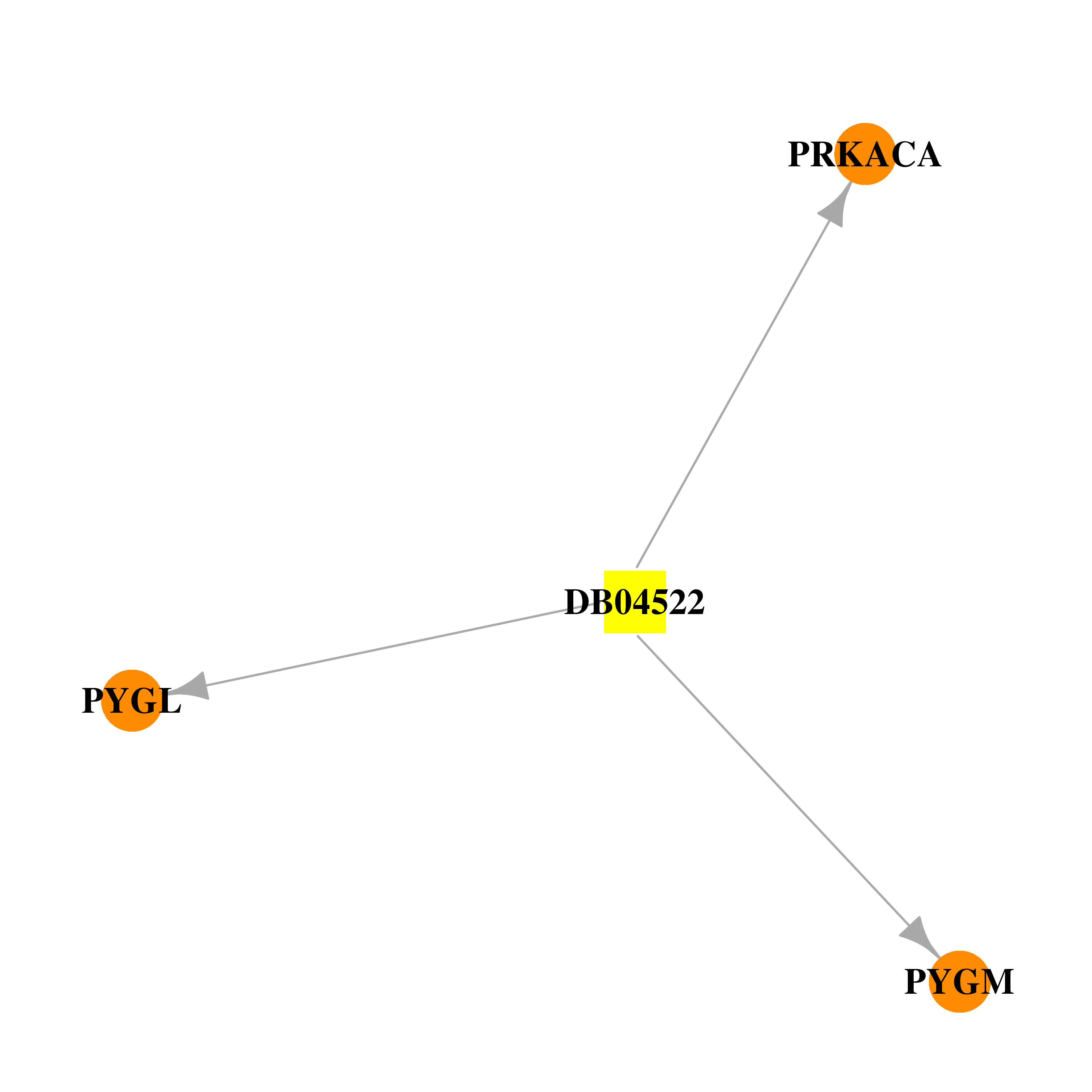 |  |
| DB07315 | phosphorylase, glycogen, liver | experimental | 5-chloro-N-{4-[(1R)-1,2-dihydroxyethyl]phenyl}-1H-indole-2-carboxamide |  | 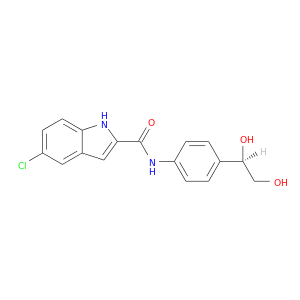 |
| DB07395 | phosphorylase, glycogen, liver | experimental | 4-[3-(2-Chloro-4,5-difluoro-benzoyl)ureido]-3-trifluoromethoxybenzoic acid | 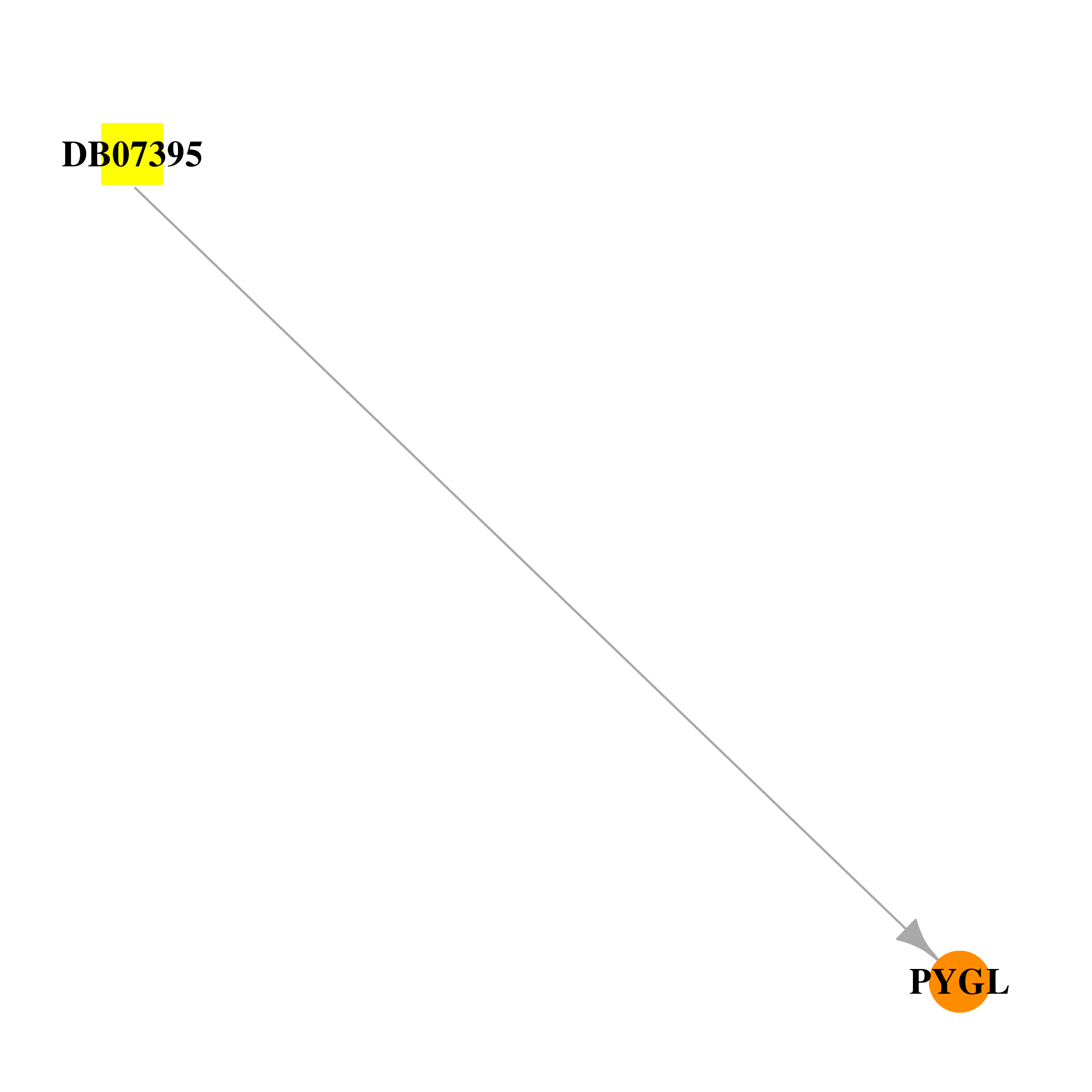 |  |
| DB07396 | phosphorylase, glycogen, liver | experimental | 1-{2-[3-(2-Chloro-4,5-difluoro-benzoyl)-ureido]-4-fluoro-phenyl}-piperidine-4-carboxylic acid |  | 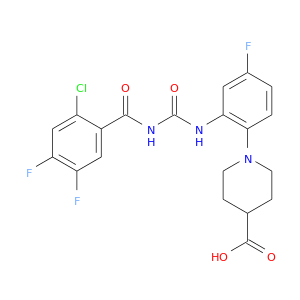 |
| DB07968 | phosphorylase, glycogen, liver | experimental | N-(2-CHLORO-4-FLUOROBENZOYL)-N'-(5-HYDROXY-2-METHOXYPHENYL)UREA |  | 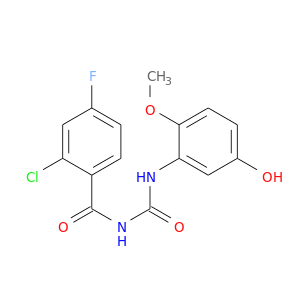 |
| Top |
| Cross referenced IDs for PYGL |
| * We obtained these cross-references from Uniprot database. It covers 150 different DBs, 18 categories. http://www.uniprot.org/help/cross_references_section |
: Open all cross reference information
|
Copyright © 2016-Present - The Univsersity of Texas Health Science Center at Houston @ |








